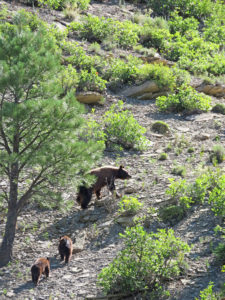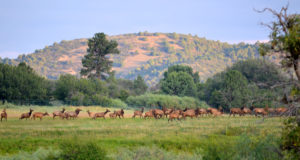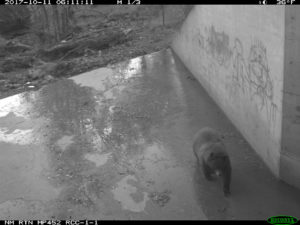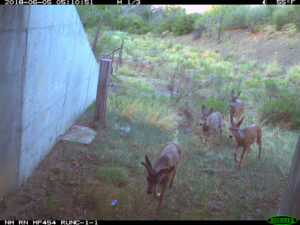The Wildlife Corridors Act ― A Plan for Safe Passage In New Mexico

(photo courtesy of Mark Watson, NM Dept. of Game & Fish)
The American West is undergoing radical change, no matter how you slice it. The country’s fastest growing cities are here, bringing with them a shift in social and political demographics. The economic drivers of yesterday, be they fossil fuels, mining, agriculture or forestry, are rapidly evolving as technology, tourism and recreation take root. These patterns can be seen in urban areas, but are perhaps most stark in our rural communities, where small towns struggle to adapt to a generational exodus, the seasonality of tourism, and a growing uncertainty of land-based economies.
Within this socio-political tumult, wildlife faces uncharted territory as they navigate changing land use, increased disturbances and fragmentation of the habitats on which they depend, and growing uncertainty as to the viability of their current ranges, historic migration corridors, and critical resource availability.
While debate continues over the good, bad and ugly innate to change, one proactive step has been taken by New Mexico’s elected leadership. With the recent signing of the Wildlife Corridors Act (NMSA Chapter 97) into law, Governor Michelle Lujan Grisham and the 2019 New Mexico State Legislature have recognized the importance of identifying our state’s key wildlife movement corridors.
Research over the past several decades has shown that wildlife corridors, or the pathways animals take when navigating across a landscape, as well as the degree of connectivity between various seasonal habitat types, play a critical role in the continued survival of mobile species such as elk and deer. However, due in part to the changes previously identified, large contiguous and unfragmented landscapes are becoming increasingly rare, generating the need to protect those corridors if we are to maintain population viability.
Despite their initial trepidation, deer learn to use the wildlife underpasses.
(Photo courtesy of NM Dept. of Transportation)
This legislation, a first of its kind in the country, directs the New Mexico Department of Game and Fish and the New Mexico Department of Transportation to advance an action plan identifying key roads and other barriers impacting wildlife movement, in addition to prioritizing future infrastructure for safe animal passage and road safety. The construction of underpasses, overpasses and other measures for wildlife not only enhances important connectivity between habitats, but importantly reduces and/or prevents wildlife-vehicle collisions. The cost to human life is conceivably immeasurable, but the costs to human capital have been estimated in the tens of millions of dollars annually in New Mexico. And while the act only provides some preliminary seed money to initiate planning and strengthen the best available science in generating what the Act calls a “Prioritized Wildlife Corridors Project List,” additional investment in future state budget requests will guide the strategic implementation of the bill.
Significant work remains in building resilience against the myriad changes affecting our state’s wildlife populations, but this legislation offers an initial first step in an effort to ensure deer, elk, bighorn sheep, pronghorn, black bear, and other charismatic species can safely traverse our increasingly fragmented landscape.
This legislation brings into focus an issue which is paramount to the future of New Mexico’s rural economies and continued natural heritage. The history of conflict between proponents of agriculture and wildlife is as true to New Mexico as is our shared love of chili. Private landowners have often been left out of discussions around wildlife management, despite private land playing host to much of the lower elevation wintering and critical riparian habitats that New Mexico’s wildlife depend upon. At the same time, the need for strong leadership on wildlife conservation has never been of greater importance as our state, country, continent and world face ever growing threats of biodiversity loss at a rate unprecedented in the modern age. The trails of mistrust run long and windy, and while legitimate differences exist between these stakeholders, the products of this conflict are animosity and indecision, while the struggles of both rancher and wildlife continue to persist.

Elk herd passing through Trout Stalker Ranch in Chama, NM.
(Photo courtesy of landowners Dan & Ashlyn Perry)
Instead, when we think about the collective benefits wildlife provides New Mexicans, whether it is the landowner seeking income diversification through hunting, a couple enjoying a ‘New World’ safari experience in the Valles Caldera or a Puebloan family rekindling native harvest foods of their ancestral past, it becomes easy to appreciate the investment in healthy, sustainable wildlife populations and their habitats.
The implementors of this Act must recognize that nearly half of New Mexico’s 77 million acres are privately owned, and many of the best examples of wildlife and natural resource stewards are ranchers and other private landowners who, by maintaining their lands in native grassland, forests and savanna, inherently protect the movement corridors that are essential to species’ survival.
With the funding mechanisms that could stem from the Wildlife Corridors Act, tribes and private landowners are poised to benefit, whether through direct habitat restoration and protection funding on their lands, or indirectly through improved wildlife populations which bolster revenue streams.
New Mexico’s move to identify and protect corridors has a shadow at the congressional level, where U.S. Senator Tom Udall introduced his Wildlife Corridors Conservation bill to bipartisan support, on the heels of the United Nation’s ominous biodiversity report predicting that one million species would become extinct by 2100 due to human impacts to landscapes worldwide. Similar to New Mexico’s Act, Udall’s bill calls for federal agencies to work collaboratively in removing both the barriers between jurisdictional boundaries inherent to land management across tribal, state, private and federal lands, as well as the physical barriers hampering wildlife movement across these landscapes.
There are important improvements that can be made to these bills, such as the inclusion of flyways and other wildlife migration stories, and the implementation of these policies must involve all stakeholders at the table, but in the end, these forms of legislation can be seen either as yet another tool wedging division amongst our land stewards or as a measure of collective pride demonstrating our united front to ensure New Mexico continues to shepherd its unique and valuable natural heritage for the betterment of our communities in a changing world. #


